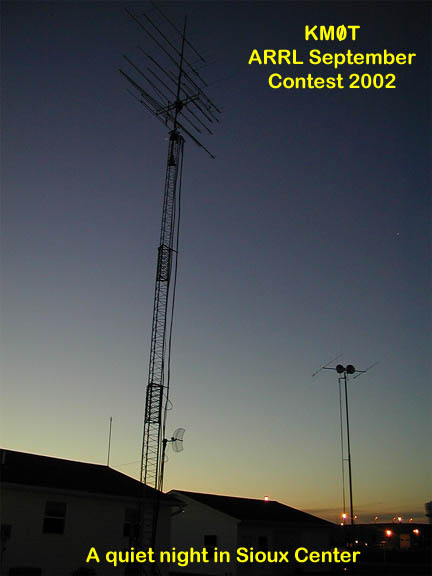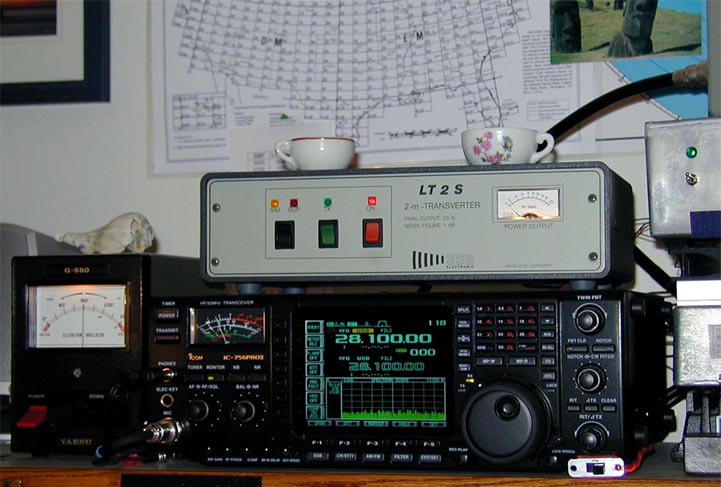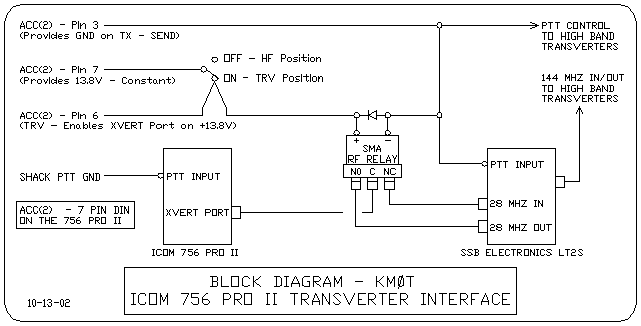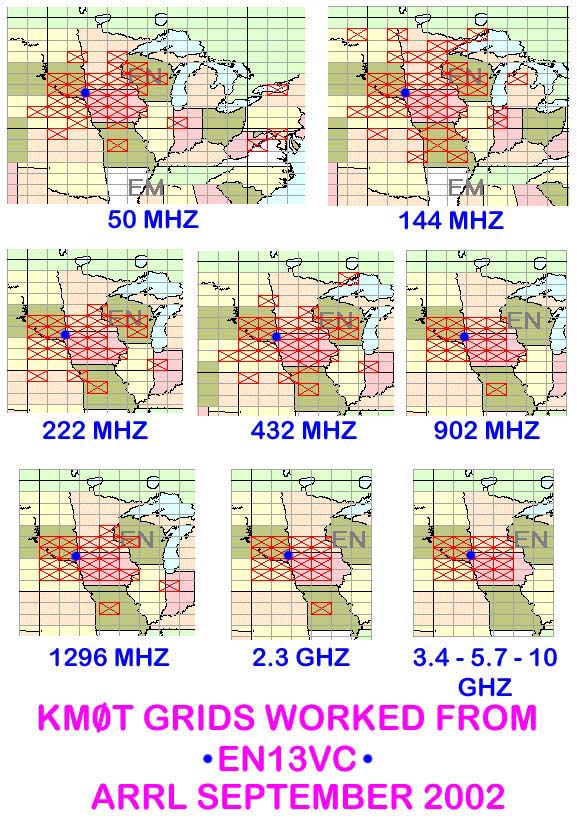

Everything seemed to be working here at the QTH of KMØT. All the equipment was humming and nothing seemed to be in need of repair. (for once!) In addition, NØDQS rover had all his equipment working as well. Gene and I did some tests early in the week before the contest and all was working fine business. I had just recently repaired the 5.7 gigahertz transverter and remounted that unit in the box for the rover dish. As it turned out, the pin diode switch was toast and needed to be repaired.
It was kind of a bummer taking apart the "Hybrid" 5.7 Ghz setup, where I had a DB6NT on TX and a DEMI on RX, but it had to be done. (See the UHF 2002 Contest write-up about the "Hybrid") That configuration was good enough for a few more states on 5.7 Ghz for the years CSVHF "States Above" 50 Mhz Event, as well as 8 grids during the UHF Contest, so we were pretty excited to see how many grids he could do during this contest as well. Gene was planning a 15 to 16 grid expedition during the contest if everything held together during its course.
New IF - ICOM 756 Pro II and SSB Electronics LT2S:
One this contest gave me time to get a feel for the Icom 756 Pro II as an IF rig for the high bands. This radio via its transverter port and set on 28 Mhz, fed a SSB Electronics LT2S 144 Mhz transverter, which is then switched to all the transverters for 902, 1296, 2304, 3456, 5760 and 10 Ghz via one of my IF switchboxes. Below is a picture of the setup....

The elevation rotor on the left is the elevation control for the 5.7 and 10 Ghz dishes on tower #2. The small switch on the lower right is the transverter enable function for the 756 Pro II. The tea cups and shell are from Patricia, she likes to add her decorating touch to the Ham Shack!
I have found that other than the minor annoyance of different RF levels of output from the 756 Pro II based on whether your on SSB or CW, the ability to see the signals on all the high bands has been an outstanding advantage. If signals are reasonable to somewhat unreasonable, then one can see them and it really helps in finding them quickly, essentially eliminating one more variable in terms of making the QSO. I am still trying to get to the bottom of the varied RF level. I may end up trying to feed the LT2S via the regular RF output of the Icom 756 Pro II with a large (30db) 100 watt attenuator on the TX line. That gets 100 watts down to the millawatt range, which is the drive levels required for the LT2S. I am wondering if this will get the TX output more in line with one another based on mode. Anyone with any information in this regard, please let me know. Note that it is not a microphone gain issue.
The one advantage of using the XVERT port on the 756 Pro II is that it is disabled very quickly by use of a switch, then allowing use on HF and 6 Meters without disconnecting and reconnecting stuff.
Ease of use I also found on the ICOM was very good and intuitive. The noise reduction is very good and digital filtering has been outstanding. The digital adjustable CW filters really help on the weak ones and the signals really jump out of the noise when you get on them. However, when the high band stuff is drifting around, I have to get the filters wider in order not to loose the signals in the passband. I have gotten very adept at using the RIT!
Here is a diagram of the ICOM 756 Pro II transverter interface with the SSB Electronics LT2S 144 Mhz transverter.

The Contest and Propagation:
Conditions were pretty much local, no 6 Meter Es and very little tropo. Had a bit of 6 Meter SSB scatter on Sunday morning, and a few brief tropo openings to the East, Northeast and South. Nothing heard again from the west or Colorado. I did some WSJT to the East for scatter on 6M and 2M, but little activity, so I managed a short nap in the night.
Gene - NØDQS/R went out again and we had a goal of working him on 5.7 and 10 Ghz from all the grids he was in. It went very well and we only had trouble in a few grids getting pointed at one another. Normally it would take only a few minutes. Sometimes we had it right on the first time. A few times we needed to liaison on 222 Mhz to get pointed, sending a beacon signal. We would get on 10 Ghz and get peaked because that's where the higher power was (10 Watts). At that point we would go to 5.7 Ghz and the 250 mW worked every time. I believe we worked on CW from only one grid, the rest were SSB. Most contacts average just over 100 miles, the longest around 130 miles, a few short distance ones were also in there, pointing was not much an issue there. 3.4 Ghz and lower were never an issue. I was very happy on how all the equipment worked and look forward to some better conditions during the contests so that I can get some high band contacts out of the EN34 gang and others to the east.
Contest Summary: KMØT SOHP
| Band | QSOs | Pts | QSO Pts | Grids |
| 50 MHZ | 66 | 1 | 66 | 33 |
| 144 MHZ | 98 | 1 | 98 | 42 |
| 222 MHZ | 39 | 2 | 78 | 25 |
| 432 MHZ | 55 | 2 | 110 | 30 |
| 902 MHZ | 23 | 3 | 69 | 18 |
| 1296 MHZ | 30 | 3 | 90 | 21 |
| 2304 MHZ | 19 | 4 | 76 | 17 |
| 3456 MHZ | 17 | 4 | 68 | 16 |
| 5760 MHZ | 16 | 4 | 64 | 16 |
| 10 GHZ | 16 | 4 | 64 | 16 |
| Totals All Bands | 379 | 783 | 234 |
KMØT CLAIMED SCORE: 183,222 SOHP
This was my best effort yet for September. (In 2001 - 131,144 points and 351 QSOs - 2000 was 81,324 points.) Adding 5.7 and 10 Ghz dint hurt either.....
"The Roverís Corner" ©
What can I say, the rovers helped out. Here is the chart of Rover activity I worked:
| BAND | NØDQS/R | WØAMT/R | KCØLBT/R | KB9TLV/R | KØPG/R | K9ILT/R |
| 50 MHZ |
16 |
1 |
2 |
|||
| 144 MHZ |
16 |
1 |
2 |
2 |
1 |
1 |
| 222 MHZ |
16 |
1 |
||||
| 432 MHZ |
16 |
1 |
1 |
|||
| 902 MHZ |
16 |
|||||
| 1296 MHZ |
16 |
1 |
||||
| 2304 MHZ |
16 |
|||||
| 3456 MHZ |
16 |
|||||
| 5760 MHZ |
16 |
|||||
| 10 GHZ |
16 |
|||||
| Total Qsos |
160 |
4 |
4 |
4 |
1 |
1 |
Total Rover QSOs = 174
Rover QSOs % of Total QSOs = 46% WOW! This is down in percentage from last September contest. (181 Rover contacts - 51.5% total of QSO count) A lot of this is due to no 6 Meter conditions as well as poor propagation to reach farther out rovers. Again, thanks to all the rovers, Gene drove quite a bit again! Nice to get a few more rovers in the log!
GRID CHARTS
Here are some grid charts showing the extent worked on the various bands. These where clipped from Vqlog. I was able to export in ADIF format for my contest data from VHFDX (which I feel is superior in speed and ease of use for logging these VHF contests) The data transfers very quickly to Vqlog without any problems. The neat thing about Vqlog is that it has the ability to generate graphs, maps and charts based on the QSO data.

Oh, it was Patricia's 4th birthday that weekend. As you can see I look a bit strung out from the contest! She sure is growing up quick!

73 - See you next time!
Mike - KMØT EN13vc